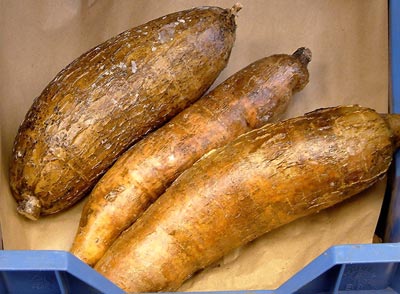
Tapioca. Cassava. Manioc. Yuca. Fleshy, starchy tubers with tough brown skin and crisp white flesh, originally from Brazil but now widely cultivated. There are two types, sweet and bitter. Avoid the bitter one. Throughout the Amazon basin there are 26 varieties, each thriving under different conditions. The process of making it into flour or tapioca removes the toxins.
Beef tartar. This is made from very finely chopped raw fillet of beef mixed with onion, gherkins (US: dill pickles) and capers and formed into the shape of a steak. A depression is made in the top into which a raw egg is broken. It is eaten raw. The meat really should not be minced (US: ground). It is thought to have originated with the fierce Tartars of the Baltic region of Russia who shredded the meat with a knife and ate it raw.

The edible crab measuring as much as 20 cm (8”) across. This is a beast with well flavoured, succulent brown and white meat. I prefer a good fresh crab to lobster, though a good fresh lobster will do! The brown meat is held inside the carapace or shell, while the white meat is found, with a little effort, in the claws. It is fished in the eastern side of the Atlantic rather than the Mediterranean but is available in markets not on the Atlantic.
Russula. Around 750 worldwide species of mushrooms compose the genus Russula and by no means are all of them edible. They are typically common, fairly large, and brightly coloured - making them one of the most recognizable genera among mycologists and mushroom collectors. Their distinguishing characteristics include a white to dark yellow spore print, brittle free white gills, and an absence of partial veil or volva tissue on the stem. Members of the related Lactarius genus have similar characteristics but emit a milky latex when their gills are broken.